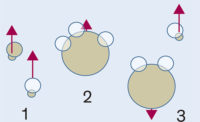Improving Efficiencies Through Technology
By Richard Mitchell
Packers and processors are increasingly turning to advanced technology in efforts to enhance product quality and productivity.
Meat and poultry plant operators must be able to make decisions based on accurate and up-to-date information if they are to achieve maximum productivity. And such data is becoming easier to obtain as more hardware, software, and technology service providers develop products aimed at enhancing plant efficiencies.
Indeed, companies increasingly are deploying sensors and monitors to electronically track virtually all aspects of their operations, and they are utilizing software programs that analyze plant data and highlight areas in need of improvements. The tools gauge such variables as production speeds, product weight, and building temperatures.
“Plants that can move more products through production lines using the same number of workers will improve their bottom lines, so it is important to have systems that can build those efficiencies,” says Stewart Ward, director of operations for Aspen Systems Inc., a Phoenix, AZ-based provider of food-plant technologies.
Aspen writes the software and provides hardware to track activity throughout a production facility. The equipment enables users to tag inventory with bar codes listing such data as the age, weight, and lot numbers of meat and poultry.
The bar codes can be read with stationary and handheld scanners, and the information is transmitted via radio frequency systems to central data repositories.
By generating real-time reports from the databases, managers can determine, for instance, if they are producing enough products to meet demand, or if inventory should be moved from coolers to refrigeration units to prevent spoilage.
Plants typically can achieve efficiency gains of between 10 percent and 30 percent after implementing electronic tracking tools, Ward notes. Benefits include labor force reductions and reduced shrinkage.
Major challenge
The main challenge for companies implementing sophisticated data management technologies is in educating floor personnel — who are typically among the least- educated workers in a facility—on how to operate the systems, he says. Many of the employees have difficulty understanding English and are unfamiliar with computer-based tools.
To help rectify such issues, Aspen, which markets Phoenix Food System, a Unix-based software product, and Canopy, a Windows-based-tool — offers programs that disseminate data in multiple languages.
Providing meat and poultry managers with real-time data analysis also is a key function of the technologies being marketed by Atlanta, GA-based Thinkage. With its Think Gates Quality Assurance Reporting System, the service provider can generate operating information by installing hundreds, and sometimes thousands, of sensors throughout a facility that are linked together in a peer-to-peer control network. The devices track activity and transmit pertinent data over a wireless network to a central database.
Sensors, for instance, could monitor the rotation speed and thermal mass of ingredients in blenders that mix meat with marinade to help insure there is consistency among products.
The technologies also help to reduce machine downtime by gauging if freezers are being overloaded – and if conveyor belts are operating at the proper rates.
Product shape, color, and composition also can be analyzed to insure compliance with acceptable operating procedures.
“Operators who are given the right information at the right time will make the right decisions and take the right action,” says Mark Grace, Thinkage president. “The question is — do they have the correct data?”
Thinkage owns the sensors and hardware, and has an in-plant coordinator providing analysis of the measurements. The coordinator also trains users in making real-time decisions.
“The main goal is for plants to produce consistent products because that is what customers expect,” Grace adds. “Sensors also help to control utility costs by measuring energy output, but it’s most important to first get the product right.”
In addition to monitoring product quality, systems also are tracking efficiencies throughout the processing cycle. Some suppliers, such as Peosta, IA-based SFK Technology Inc., provide turnkey systems that utilize radio frequency transmission tools and database management programs.
In a hog facility, for instance, SFK ID tags attach to trolleys transporting pigs and are read by radio frequency identification (RFID) sensors to enable operators to determine precisely the time it takes to move the animals into coolers after being stunned. Grading information for each carcass, as well as the primal weight, trim codes, and health information, also is electronically entered into databases and all information is linked through an Oracle-based management and networking system.
The system has a 99-percent accuracy rate in reading the tags, says Jeb Supple, SFK Technology sales manager.
Proof positive
Meadowbrook Farms Cooperative, a Belleville, IL-based pork processor that is owned by 200 individual pork farms, this year began installing automated data management tools from SFK and several other providers in order to garner the data that will enable managers to make more timely and accurate business decisions, says Jim Burke, president and CEO.
The technology also enables Meadowbrook to create audit trails in order to track inventory back to the originating farm for payment, and to help certify the contents of items when the products starts offering specialty products, such as organic pork, Burke says.
“The level of information on carcass quality that we’re trying to tie back to the farm would not be possible using manual systems,” he notes. Product weight, yield, color, and pH levels are among the attributes being tracked.
Meadowbrook Farms has invested between $1.5 and $2 million in the technologies, and Burke says the biggest implementation challenge is integrating all the necessary components.
“There is not one vendor that can provide a total solution for us, so a lot of work needs to be done to match up the pieces,” he adds.
In addition to monitoring the status of inventory and plant productivity, automated systems also are being designed to register and analyze temperatures in facilities and shipment vehicles.
“So many manufacturers focus on producing high-quality meat and poultry products, only to have the inventory abused as it goes through the cold chain and before it reaches the customer,” says Jeff Leshuk, general manager of professional services for Sensitech Inc., a Beverly, MA-based developer of temperature monitoring apparatus.
The cold chain is comprised of the refrigerated links in the distribution system that meat and poultry typically traverse when moving between the processing or packaging plant, and the retail store or restaurant. Components include storage rooms, shipping docks, and transport systems.
Maintaining optimal temperatures at each stage is essential if the meat and poultry is to retain its color and quality, but too often freshness is compromised by a failure to detect faulty refrigeration units, Leshuk notes.
“The cold chain only is as strong as the producer’s weakest link, so it’s crucial that the temperatures at each segment meet the necessary criteria,” he says.
Sensitech’s products include the TempTales electronic temperature monitors that record and store time and temperature information, which then can be downloaded to a central database for analysis. Monitors also can track humidity.
By situating monitors throughout plants, operators are able to create thermal mapping systems that provide three-dimensional views of a facility’s temperature patterns. Similar to a weather map, the renderings display gradients that reveal temperature abnormalities.
By leveraging the data, users are more easily guided to areas with cooling problems. Typical sources include damaged walls or doors that remain open too frequently.
Aggregate readings from hundreds or thousands of shipments also can be distilled to pinpoint the trucking companies with inadequate refrigeration systems.
And by downloading temperature data immediately upon the arrival of a shipment, retailers and other product recipients can decide on the spot of whether to unload a trailer or to send the untouched meat or poultry back to the distributor.
Readings from the monitors typically are transmitted to a central database by placing the hardware in a cradle that attaches to a computer’s USB port. The information then can be sent to Sensitech’s Web-enabled Cold Chain Manager reporting tool for analysis.
Sensitech’s next generation of products is expected to leverage radio-frequency technologies to transmit readings to receiving stations.
“Many cold-chain issues have fallen into the cracks or have not been addressed properly because the technology and expertise was not available,” Leshuk notes. “But it is important to determine how a product is cooled initially — and if it is refrigerated sufficiently during the various stages of delivery.”
The demand by processors of all sizes for automated temperature-tracking units also spurred development of the new Multi-Zone Temperature Monitoring System-Data Logger from Countryside, IL-based Hollymatic Corp.
Hollymatic produces sensors and software, and each of its systems is able to support readings from 20 temperature zones, says Jim Williams, Hollymatic director of marketing. The technology enables processors to more easily meet the U.S. Department of Agriculture’s (USDA’s) temperature-reading requirements without using plant personnel to record the data, he notes.
“A lot of people spend a lot of time going room-to-room in plants documenting temperatures,” adds Steve Madison, Hollymatic regional sales manager. “Automatically recording the information means that employees do not have to break away from their normal duties.”
The Hollymatic tools also enable users to set alarms that alert operators when the temperature in monitored areas exceeds prescribed levels and allows plant personnel to monitor readings online from remote locations.
“Being able to pinpoint refrigeration levels at all times helps users determine if there are flaws in a system,” Madison adds.
Technology providers participating in this feature include:
Aspen Systems Inc., phone (800) 767-1970, fax (602) 331-1932, e-mail development@aspen-systems.com, or visit www.aspen-systems.com
Hollymatic Corp., phone (708) 579-3700, fax (708) 579-1057, e-mail rkovacik@hollymatic.com, or visit www.hollymatic.com
Sensitech Inc., phone (978)927-7033 or (800) 843-8367, fax (978) 921-2112, e-mail info@sensitech.com, or visit www.sensitech.com
SFK Technology Inc., phone (563) 582-4230, fax (563) 582-4130, e-mail
js@sfktech.com, or visit www.sfktech.com
Thinkage, phone (678) 514-3026, fax( 678) 579-9069, e-mail mark.grace@boc.com, or visit www.thinkagesystems.com
Richard Mitchell is a freelance writer living in the Chicagoland area.







